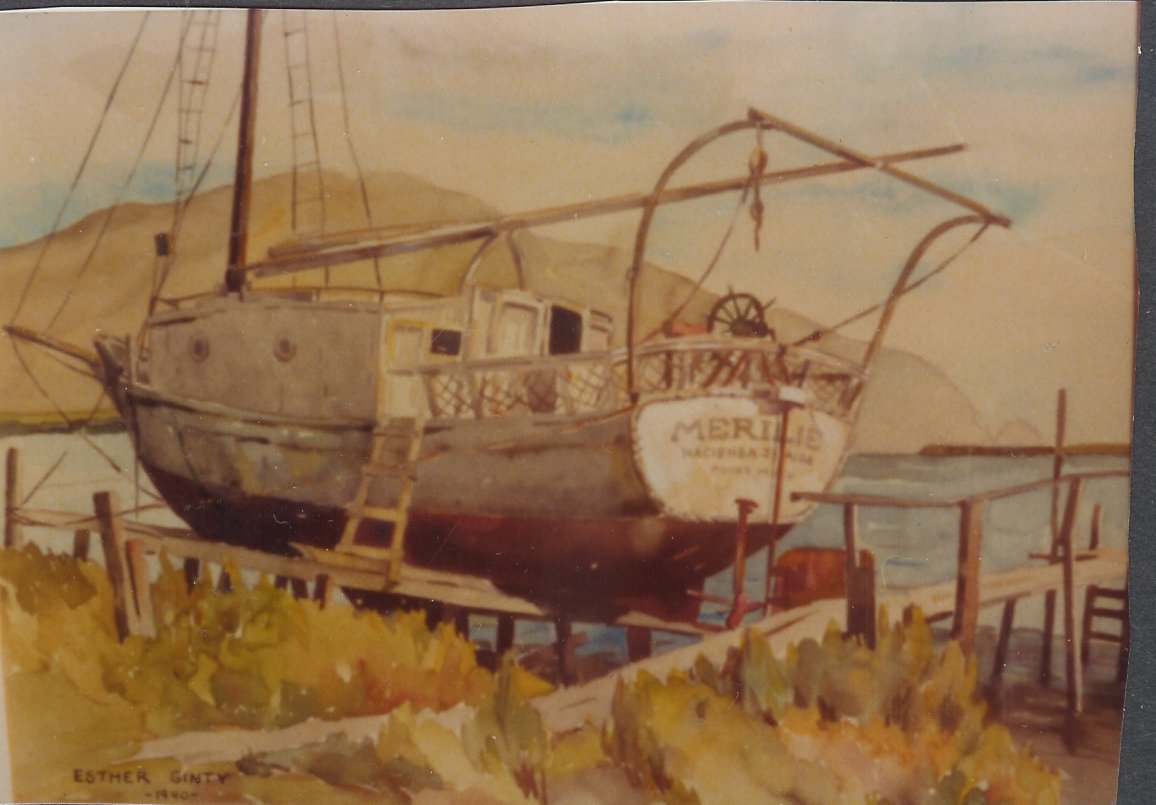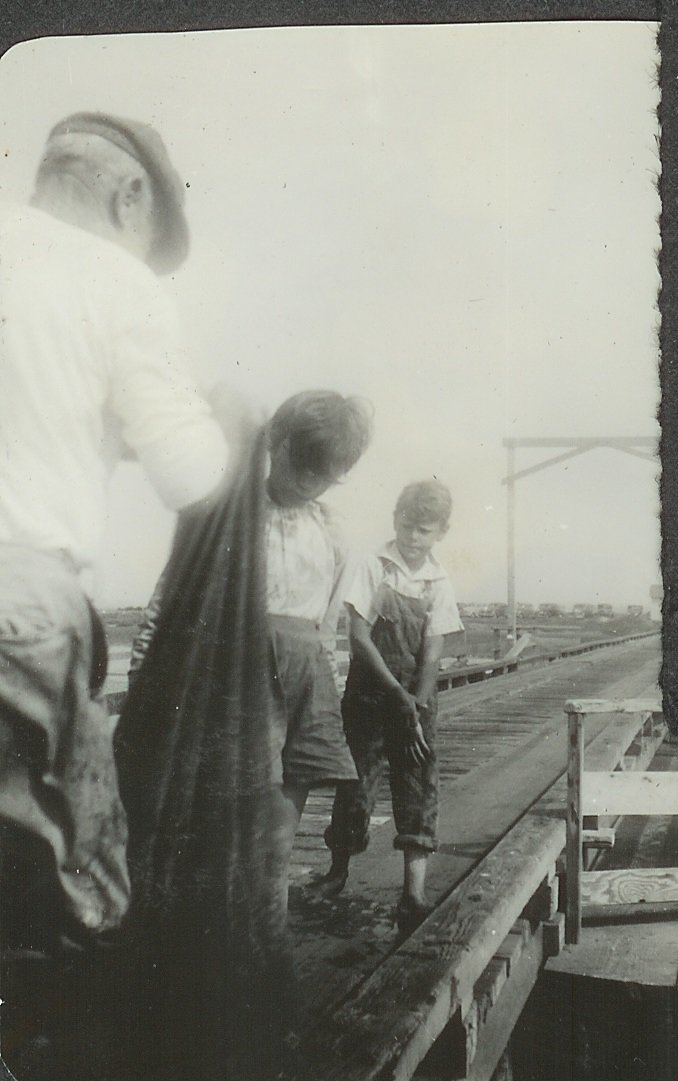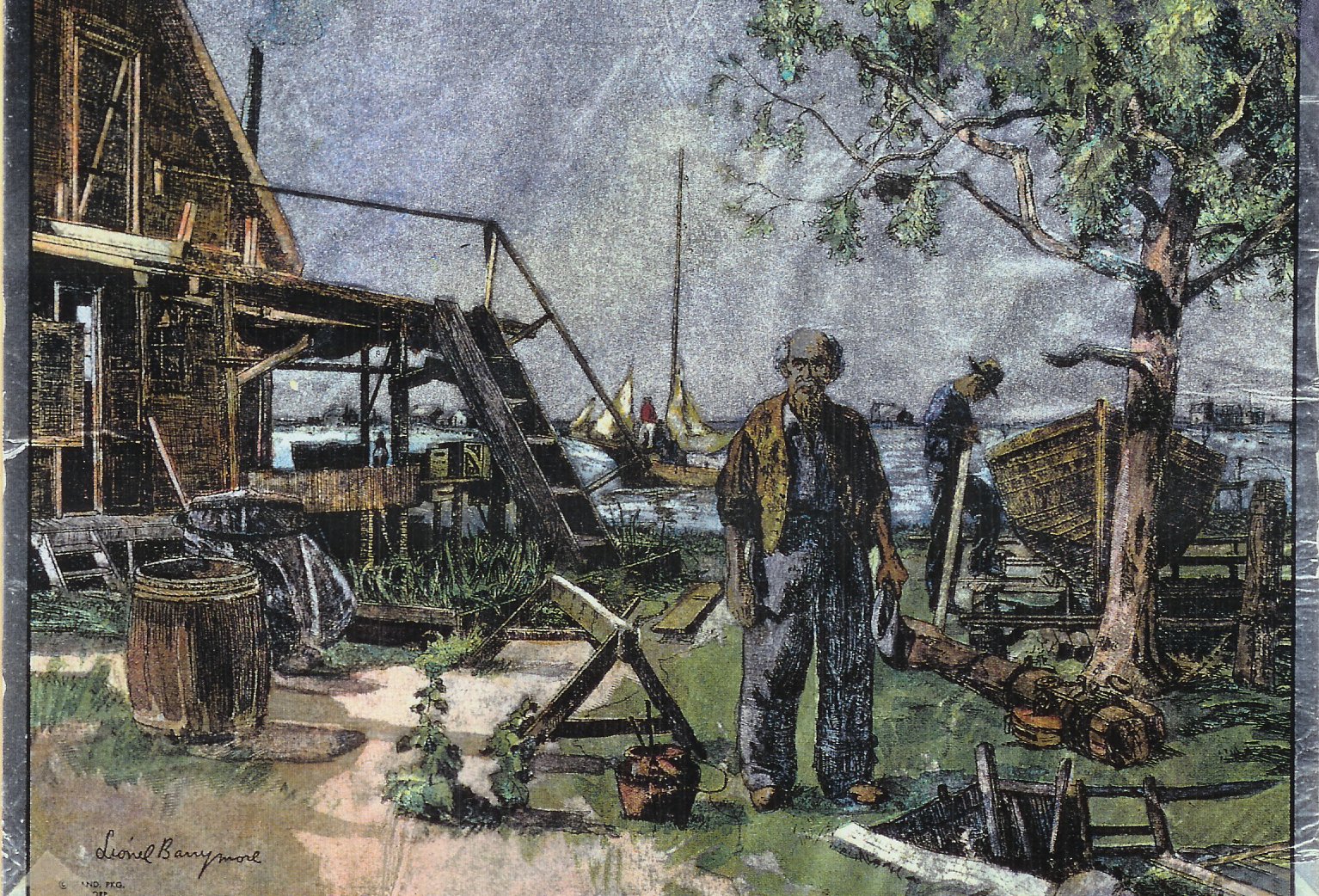THE MERILIE ANDTHE CABIN AT POINT MUGU
About 1929 or 30 my two grandfathers, Grampa Utt and Dad Robertson, collaborated to build a boat that was to be christened the Merilie, after my new baby sister. She, the boat, not my sister, was 30 feet long, 10 feet six inches wide, with a nearly flat bottom. I think that she drew only about 18 inches of water. Dad wanted to be able to get her in shallow water, and even run her up to the beach on occasion. She was fitted with a cabin, four bunks, a tiny galley, and an even tinier head. She had a mast, with mainsail, jib and what Dad called his second jib. Not to be confused with the flying jibs used on racing vessels. There were two drop-down center-boards to use when under sail. She also had a thirty horsepower Gray Marine engine. Under power she made about 5 or 6 knots. Under sail, with a favorable wind she could make 8 knots.

Dad cut natural curve oak for the ribs, from Happy Camp Canyon on the Strathearn
Ranch in Simi. The hull was a double layer of one-inch spruce. The boat was
built on a small point of land south of Mugu Rock, between the coast highway
and the sea. A young man named Russell Coleman had homesteaded the property,
and had a small cabin there.

In the house of an acquaintance, I found this painting of the Merilie. It
seems as though my friend and his mother had visited point Mugu when he was
just a boy, and she had done the painting.
This is a photo of the painting.
Dad and a Mexican helper named Pancho did the work, with some help from Russell. Grampa was not what you would call handy with tools, so his contribution was mainly financial. When the boat was completed except for the mast and rigging, it was loaded onto a truck and hauled a couple of miles north to where the road crossed a small channel of salt water. How Dad got the boat onto the truck, then off and into the water I donít know. I only know that he was perfectly capable of doing such things with ropes, pulleys, timbers and rollers.* I went down with Tom on the day that it was moved, but my only memory is of the boat already in the water. The move had been timed to a full moon, so that there would be a nice high tide, making it possible to navigate the Merilie into the deeper waters of Mugu Lagoon. *The more I think about this, the more I think that they hired a crane for this job.The Long Bay Corporation, of Los Angeles, owned all the land around the lagoon. I know this from correspondence I found years layer in my fatherís office. Dad, or more likely Tom, negotiated with Long Bay to lease two or three acres of land fronting on the lagoon. Here Dad was able to complete the rigging of the Merilie.

Dad with cast net on the bridge over Mugu Lagoon. Alan and I watching.
About this time, probably a few years later, Tom stopped growing tomatoes for seed. He had been growing on a large scale for many years. To house the seasonal workers to harvest the crop he had purchased twenty or more old 16í x 20í Army tents. Iím not sure if the wooden floors came with them, or if Tom had them made. In any case, they were made of tongue and groove flooring on 2 x 4 frames. Each floor was made in two 8 x 20 foot sections. When the tents were no longer needed, Dad decided to use some of the floors to build a cabin at Point Mugu Lagoon. He assembled the entire house on the ranch, using two sections for the floor, a section for each wall, then two more sections for the second floor, with a post in the middle of the room to support it. The roof had a very steep pitch, being fashioned from modified floor sections. The steep pitch gave headroom for the second floor. Openings were made in the wall for doors and windows. Iím not sure, but he probably used bolts to fasten the sections together. When it was finished to his satisfaction, he took it all apart, loaded the pieces on a truck and hauled the cabin to Point Mugu. I went along on this adventure, as did some of the other kids. I donít seem to have any recollection of the cabin being assembled. I do remember Dorothy taking several of us down to spend some time with dad in the cabin soon after that. The finished cabin had a shed roof on the east end, a ladder, or very steep stairs, led up to the shed roof. We crossed the roof to get to the door of our upstairs bedroom. Dad put all of us to work painting. He used an expression that I have not heard before or since. He said, "I donít want to see any holidays". By that he meant no unpainted areas. The screens were of steel wire; no copper or plastic at that time. Dad had us put a light coat of rather thin paint on them to keep them from rusting in the salt air. One of my sisters, either Jean or Rae, and I decided that we could do a really good job on the screens if we worked one on each side of the screen. As you can imagine, we got slightly carried away, and by the end of the day we were both covered with paint. Our ever patient Mother took all this in good humor. After all, we did get the job done! A dirt road ran a mile or more from the Coast Highway, across a mud flat to the lagoon and then over a long wooden bridge to the sand spit that separated the lagoon from the ocean. Dadís cabin was on the mainland side of the lagoon, near the bridge. At the other end of the bridge was a fishing camp run by a Japanese family. They had a pier to fish from, and also ran a charter boat from there. There were several tanks for live bait, a small store, and a number of cabins that they rented out. I only recently learned that those cabins were a popular hangout for some of the Hollywood people. That led to Lionel Barrymore doing several drawings of the area, including some of Dad, the cabin, and the Merilie. We have reproductions of those drawings.Our family spent lots of time at Point Mugu over the years, and there are many fond memories. I hope to write more about these memories.

Drawing by Lionel Barrymore, Signature in lower Left Corner.
The original was a black and white sketch.